A job description is a “must” if we want our team members to have clarity around
A frequently missed opportunity
When creating our job descriptions, we typically focus on establishing the performance expectations associated with a role (i.e., the tasks, duties, and responsibilities – the “what” needs to be done). And while we spend a good amount of time establishing performance expectations, we frequently miss an opportunity to establish behavioral expectations (i.e., the “how” work should be done within our unique company environment).
Focusing on behavioral expectations allows us to define how employees should approach their work, interact with colleagues, and contribute to the company culture. For example, what are the communication standards around method, frequency, and style? What do we want to see from our team members in terms of teamwork and collaboration within and across functions or departments? What about our approach to problem-solving as a company? What are the ethical guardrails within which we expect our staff to operate while they perform their duties?
Why invest the time in spelling out behavioral expectations
Leveraging our job descriptions to establish both performance and behavioral expectations elevates everyone’s understanding of a role as it exists within our company. And that expanded, richer understanding leads to several positive outcomes for our employees and our business including:
- Improved Employee Performance – providing our employees with behavioral clarity enhances their performance as they are less likely to misinterpret their roles or responsibilities. They know what success looks like, both in terms of deliverables and the attitude or approach they must take. This …
- Increases accountability by minimizing “below the line” behaviors and attitudes such as “I didn’t know” or “That is not my job.”
- Boosts efficiency, reduces friction with other team members, and allows our staff to focus on their work without second-guessing how to go about it.
- Increases their confidence in their role, reducing feelings of anxiety or uncertainty and, as such, leads to increased job satisfaction and greater engagement.
- Improves employee retention – when our job descriptions incorporate behavioral expectations, job candidates can better assess whether they fit into the company culture and decide whether to join our company. This increases the likelihood that we hire team members who are more likely to stay and thrive with us, since they align with our company values.
- Avoidance of conflicts and confusion in decision-making – when our team members know both what to do and how to do it, it enables everyone across the organization to align on how we collaborate and make decisions. By minimizing potentially conflicting approaches we speed up our decision-making and minimize misunderstandings across functions.
- Reduced frustrations and faster conflict resolution – when there is a shared understanding of how we all show up at work within our company, there is less opportunity for friction due to different individual preferences and styles. And when frustrations or conflict do arise, people leaders can reference the job description’s behavioral standards to mediate more effectively, as expectations are clearly set from the beginning.
- Improved alignment with company objectives – when our team members understand what their roles are and how their actions contribute to the overall company goals, they are able to work in sync with their colleagues, follow company protocols and adhere to company standards. By minimizing chaos, uncertainty and unpredictability, our staff is ultimately better positioned to deliver exceptional customer experiences and business outcomes.
- Intentional management of company culture – by embedding behavioral expectations we can promote and reinforce our company’s core values. By making sure every employee understands not just the job but the cultural “how” behind it, we promote a unified, values-driven environment where everyone strives for and contributes to the same goals.
Key takeaway
Leveraging a job description to establish both performance expectations (what work needs to be done) and behavioral expectations (how that work should be done) is crucial for creating a clear and complete understanding of a role within our organization. By incorporating both performance and behavioral expectations into our job descriptions, we can avoid ambiguity, reduce conflict, and eliminate chaos within our company. When our employees understand not only the “what” but also the “how” of their role, we set the stage for more cohesive teams, better individual and team performance, and stronger alignment with company values, which ultimately leads to better business outcomes.
If you want to discuss how to improve your existing job descriptions or explore how we can partner together to improve your company culture and business outcomes, reach out to talk with one of our HR experts.








